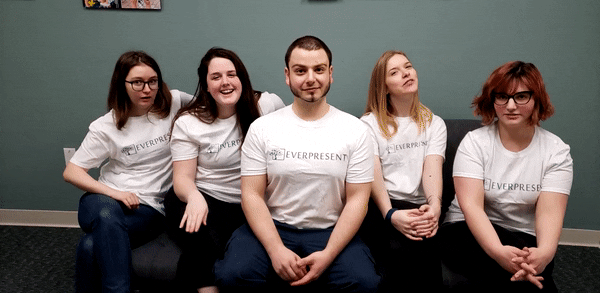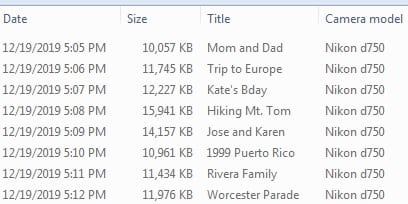We’ve been uploading photos to social media for the last 15 years. And for a while, we thought our family memories were in good hands. But social platforms actually make it much harder to organize and enjoy your pictures and videos.
EverPresent found that the average family has about 80,000 digital photos and videos stored in several different places, including social media. If you rely solely on social platforms to manage and store your photos, the side effects can be devastating:
- Compression lowers photo and video quality so files load faster and use less space
- Metadata – useful info about your files, like dates – gets deleted to save space
- Filenames get changed to whatever the platform decides
- Photos stored on hacked, deleted, and locked accounts could be lost for good
- Social sites can shut down or merge with other platforms
This three-part series (see part two here) will help you avoid these risks by showing you the right way to share your pictures and videos, and how to download your photos from social media. Our experts have organized millions of digital photos, and they’re here to warn you about what social media does to your family memories.
EverPresent: Beth, you came to us about writing this post because you were seeing a trend in your digital organizing clients. Can you tell us more about that?
Beth Cleveland: Yes! Ten-plus years ago, there was this expectation that social media sites would take good care of your photos when you upload them. It’s becoming more evident that that is not actually the case. It’s important for clients to know that – and how to fix it if they need to download those files.

In most cases, someone lost a phone or their hard drive crashed. At the very least, these files from social media platforms like Facebook, Instagram and Snapchat are a lifesaver, but they are by no means like the original files.
I want our clients to know that anything they post is only a copy of the original. Never delete the original files from your primary device. Keeping the originals ensures that you’re always working with the full-resolution files in the future.
 While compressed files are great for casual scrolling and sharing, they don’t keep your family memories looking their best. It’s hard to tell at a glance. But up close, photos shared on social seem grainy and blurry (RIGHT) compared to the originals (LEFT). Printing makes them look even worse.
While compressed files are great for casual scrolling and sharing, they don’t keep your family memories looking their best. It’s hard to tell at a glance. But up close, photos shared on social seem grainy and blurry (RIGHT) compared to the originals (LEFT). Printing makes them look even worse.
EP: Related to your point about resolution: we know that social media reduces image quality with compression, and makes files harder to sort by stripping the metadata. Are there any social media platforms that don’t pose these risks to photos and videos?
Digital Organizers: NO!
EP: Yikes. And people are trusting these sites with several years of memories, right? How far back in time does an average client’s social account go?
Margaret McCarthy: Around 2005 with Facebook. Many were in college when Facebook launched, so they were squarely in the target demographic for it.
EP: It sounds like social media’s been a big part of their lives. Are families treating their social accounts as other storage “devices” like their computers? Or is social an afterthought that you and the team have to bring up?
BC: It’s something they bring up on their own, almost like free cloud storage accounts they’d like to download from.
NOTE: Digital cameras add dates to your photos’ filenames, but some social media change these names to suit their own needs.
Facebook, for example, replaces filenames with a random serial number and your 15-digit user ID. The new names might be easier for Facebook to manage, but they don’t help you identify your own photos.
EP: Help us get a sense of social media’s place in an average client’s archive. How many photos do people normally need rescued from their social accounts?
BC: It varies widely. As few as 100, as many as 8,000 — depending on how active our clients are on social media! Photos from social could easily make up 10 percent of the final count, so in an archive of 80,000 photos, that chunk can be significant.
EP: What’s the typical content of social media photos? Are they even worth saving?
BC:Absolutely — they’re often the BEST photos in a family’s collection. Putting them on social media might feel like you’re curating or highlighting these moments, but you’re actually putting your best photos at risk. Finding out after the fact can be incredibly frustrating.
 Our expert digital organizers
Our expert digital organizers
EP: So how do photos on social media fit into your digital organizing projects with families? Do people have duplicates online, and the originals on their devices? Or do more families have lots of photos that only live on social?
BC: It’s a mixed bag. About 20 to 30 percent of people have photos on social media and aren’t sure if they’re anywhere else. We often find versions of those photos elsewhere, which is awesome. But one big issue is that clients usually prefer to keep the versions that they edited before posting to some social networks, like Instagram. These edited, uploaded copies have poor quality overall.
We sort photos by date, and the original photo could have been taken years before it’s downloaded from a social media site. So if we keep both the edited and original versions, those photos end up in two different spots in the final archive. And if we’re only keeping the edited version, then that photo gets placed in the wrong spot based on the date it was downloaded.
EP: In addition to sorting chronologically, what is the digital photo organizers’ typical process for retrieving and organizing all of a client’s media from social platforms?
MM: We do the zipped archive retrieval, which keeps your Facebook albums. We usually put it in a Facebook subfolder within a larger Social Media directory in the final library.
Sarah Medeiros: Because the files that come from these locations are stripped of their relevant metadata, we are unable to organize them further. It’s usually easier for the client to go through and move these into the right place than it is for us to put on our detective hats and dive into the weeds to figure out where they go.
NOTE: Social media sites delete metadata. Metadata is a blanket term for helpful context about your image files that makes them easy to sort.
Examples of metadata:
If you’re far enough into this post to know you need help taking control of your digital family photos and videos, let us know in the form below:
EP: Zipped archives and folder hierarchies sound a bit more complex, but super important from an organizing point-of-view. When you talk about what happens to these photos and how they fit into the scope of your organizing work, what should a client know about what’s happened to their photos since uploading? How do they react?
BC:It’s important to know that we can’t figure out when these photos were taken, so they will inevitably end up in an “Unknown Date Taken” folder. It could take the client numerous hours and a lot of effort to figure out where the files belong. Another note:
The file sizes of social media downloads are very small, so doing any printing or putting them into physical albums is not likely. Click To TweetWhat’s more, these platforms only let you batch-download an archive of what you’ve uploaded yourself — not photos other people have tagged you in. A lot of our clients use Facebook to share photos from events with each other, so downloading those photos is a manual effort and you only get small images with no date information.
Most clients don’t realize that these files are not ideal to work with, and they hope to find the files somewhere else to avoid extra work on their plate later. The biggest disappointment comes from the small file sizes, which means there’s little potential for high-quality printed projects in the future.
EP: So we’re back to the image quality issue. What happens if you shoot a photo in-app, and then apply edits like cropping or filters? Is there a way to save the unedited originals?
BC: Yes, when settings are set beforehand!
MM: If the photo was taken in social and edited in social, then only the edited version is saved to your phone, and only if your settings are set appropriately. If the photo was taken on your camera and edited in social, you will have both as separate files (if your settings are set appropriately).

EP: Besides saving the originals and adjusting app settings to save anything shot in-app, what else (if anything) should people be doing to protect photos and videos from the side effects of social media?
BC: Make albums with dates and extremely descriptive titles in social media so you can have some sort of info if they ever need to be downloaded. In these cases, the more information, the better! Also, share photos with family and friends through responsible sharing sites like Dropbox or Google Drive/Photos so they receive the best versions of those files!
EP: Almost done — you mentioned earlier that some people are using social media sort of like free cloud storage. Are there any non-social, cloud storage accounts that pose similar risks to photos and videos?
MM: iCloud shared albums also resize photos and lose video dates! Google and Amazon CAN both compress, but it’s mostly imperceptible and you can opt to pay them a moderate amount of money to store your original files instead.
EP: What cloud storage platforms do professional photo organizers recommend?
MM: Dropbox is the best for selective sharing, or for sharing space among a family – everyone can have their own folder.
iCloud is good for backing your iPhone’s photos and videos up, and emergency-sharing lots of photos.
Amazon is good for having a whole family archive that everyone’s phone is contributing to, but it’s a little weak on albums and tagging.
Google Photos is good for general sharing.
EP: And one more for the road: is there a way to sync your originals with Google/Apple Photos accounts?
MM: These accounts always ask if they can use your Camera Roll. If you say yes, they’ll automatically be added to your Camera Roll. And if you have Google Photos syncing from your Camera Roll, it’ll go there too.
Our organizing experts have to get back to work, but we are 4 months into the new year and there hasn’t been a whole to do EXCEPT take pictures and engage on social media. We want to make sure you have all the facts.
Check back next week when we share best practices for uploading those videos and photos to social media without losing valuable details. We’ll even show you how to download your whole archive from Facebook and Instagram the week after that.
Until then, click the infographic below to learn how parents REALLY feel about sorting their digital photos!
What We Learned About Parents and Their Family Photos



